
Would you like to create your NFT minting platform but don’t know where to start?
Creating an NFT minting platform can be a daunting task. In addition to having to navigate the often-confusing crypto terminology and jargon, one also needs to have a good technical understanding and be able to identify potential security risks. With so much changing daily, it can be difficult to keep track of what’s needed to build your perfect NFT minting platform.
What Are NFTs?
Non-fungible tokens (NFTs) are a unique type of cryptographic asset that is quickly gaining popularity due to their many applications and use cases. NFTs are unique in that each token is completely different from any other, making them perfect for representing physical or digital assets. Non-fungible means unique, one of a kind, irreplaceable.
NFTs are built on Blockchain technology. This allows them to be stored securely and traded easily. NFTs can represent anything from digital art and collectibles to in-game items and even physical assets like real estate or cars.
How Do NFTS Work?
Let’s say somebody sells you a piece of digital artwork online. With NFTs, they would also provide you with the ownership rights of the piece. You will now become the official owner of the art piece, though the actual owner can still have rights to copyright and reproduce the piece.
Why Do NFTS Work?
Addressing why NFTs are working well in today’s day and age is just as important as addressing the how piece. The main reason why NFTs are taking off is because they produce digital scarcity, a concept that has been a challenge in the digital world ever since it came about. In other words, only one person can own a single NFT at a time.
Just think about it. How many times have you heard about art being replicated so that there are more and more copies of the same piece being produced, with no indicator as to which one is the original? Millions of digital assets have lost their value because of this, and NFTs are the solution to bring back value to original work.
Another reason why NFTs are attractive for many is the ability to eliminate any third-parties between artists and their buyers, whether it is digital art, music, games etc. The absence of a third-party to help make the transaction allows the original artist to keep around 90% of the profits; the other 10% goes to the NFT minting platform being used.
What happens after the original seller sells his or her digital asset? Well, if they choose to add royalties, they can earn a profit from each sale made afterwards. This is a great way to ensure that artists are fairly compensated for their work and that they can continue to generate income from it long after the initial sale.
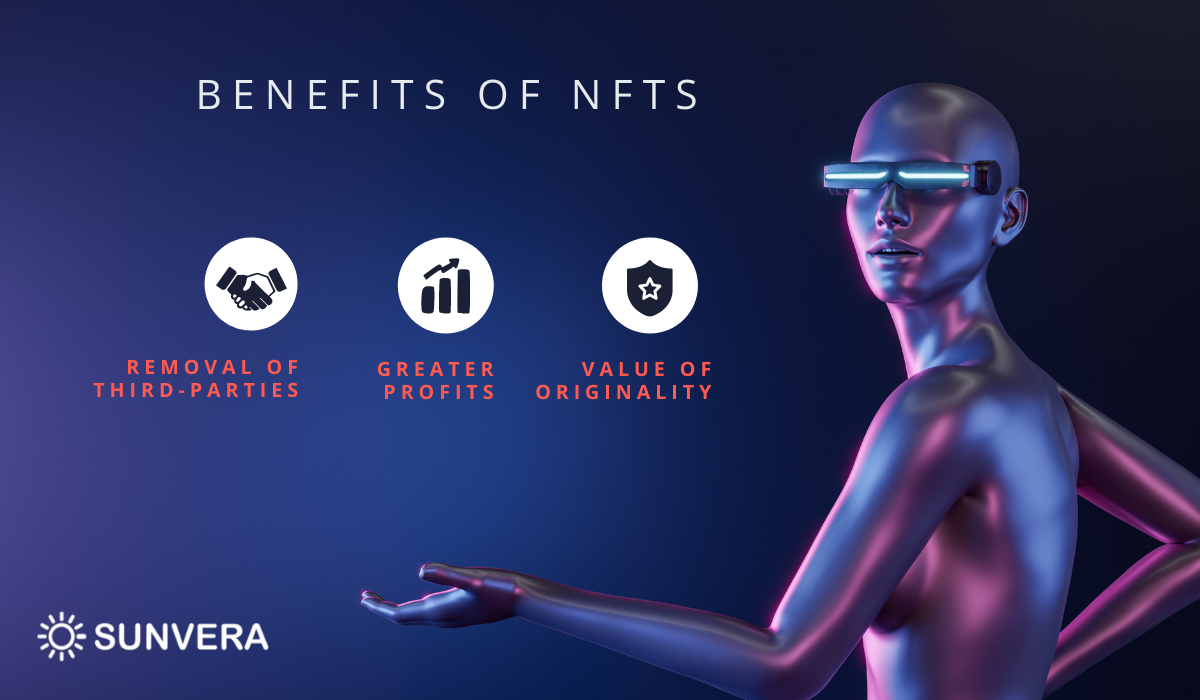
Applications of NFTs
Here are some potential applications of NFTs that could be used on your minting platform:
Collectibles
NFTs are especially popular among collectors, as they can be used to represent unique physical or digital items. This could include assets such as rare stamps, vintage cars, or even digital content such as songs or videos.
Gaming Assets
NFTs can also be used to represent in-game artifacts and items. These could be anything from weapons and armor to unique skins or game worlds. You can also buy virtual land within the game. This allows people to engage more with the game, and invest in it, both mentally and physically.
There is a term going around in the gaming world currently, and it’s called ‘play-to-earn’. These games are generally free to download, but you cannot play them without NFTs, which must be bought separately. The play-to-earn model follows the concept of GameFi, where game assets are traded for financial rewards, in this case, crypto. The more crypto you earn, the more NFTs you can purchase to trade and sell within the game.
Digital Ownership
NFTs can be used to represent digital assets and content such as website domains, social media accounts, or even cryptocurrency wallets. As mentioned before, the original owner of a digital asset can continue to gain value from their asset if they choose to add royalties. This is where digital ownership really comes in. The original artist never really loses their connection with the asset, even if they have sold it to somebody else.
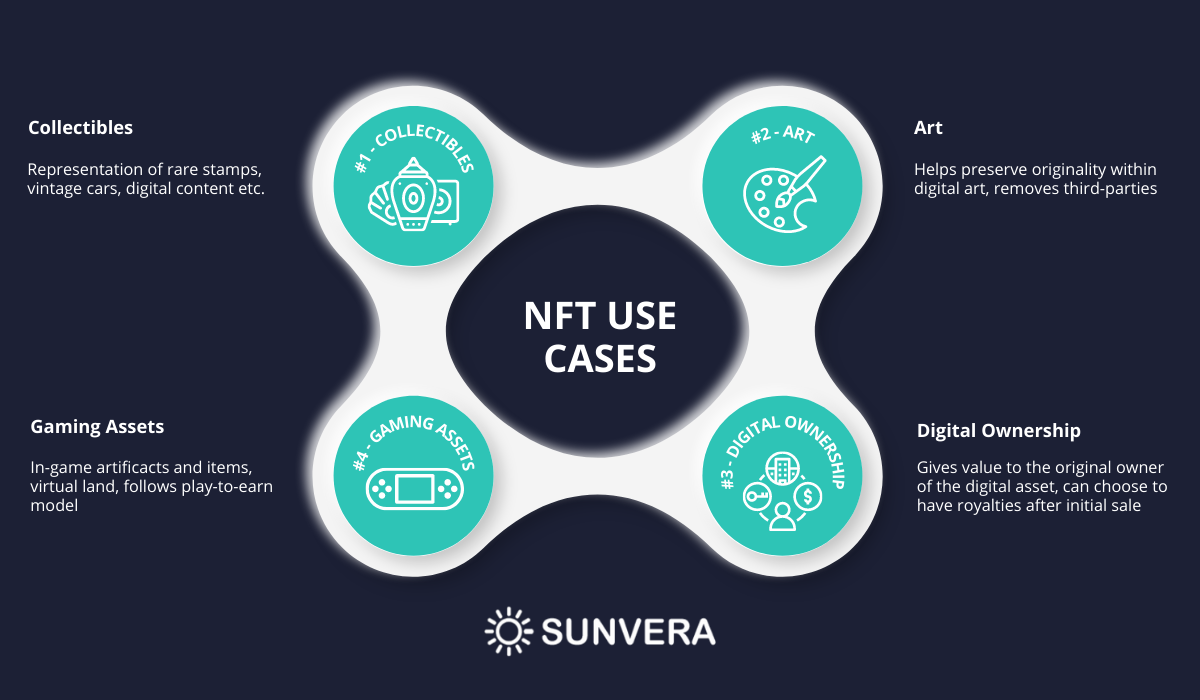
Highest NFT Sales
The most expensive NFT sale to date is $91.8 million, and it is Pak’s ‘The Merge’, sold in December 2021.
Following that one is the $69 million for Beeple’s ‘Everydays: The First 5000 Days’. This piece is a digital collage of sorts, made up of elements from Beeple’s everyday life over the span of 13 years.
Moving away from artwork, other industries are making massive NFT sales. In the music industry, Kings of Leon are sending an NFT to space for charity, where the bidding starts at $50,000.
Virtual property is also going for millions. In November 2021, ‘Decentraland’ sold virtual land for $2.4 million. This is known as the largest metaverse acquisition so far.
NFTs are changing the way we think about digital assets and content, and there is no doubt that we will see more multimillion-dollar sales in the future. With the ability to represent just about anything, it’s not hard to imagine a world where everything is tokenized.
Why Use NFTs (Besides the Profitability Piece)?
Besides digital ownership, there are many reasons why you might want to use NFTs:
Security
NFTs are stored on the blockchain and cannot be tampered with or stolen. This makes them ideal for storing valuable assets. The removal of a third-party also helps increase security, as the sale or trade is made directly within the seller and buyer. Blockchain networks are known for secure data encryption due to operating on a decentralized system. There are many uses of NFTs to enhance security, including using smart contracts, encrypted messaging, and more.
Portability
NFTs can be easily transferred between users, making it easy to trade and sell assets. NFTs are stored in secure wallets, which can be used to make transactions wherever they are. The ability to store these tokens in an online wallet that is both secure and portable makes them a highly attractive option.
Simplification
NFTs possess the power to remove intermediaries and simplify transactions, while making them more secure and less prone to fraud. It’s a win-win situation.
What is NFT Minting?
When you ‘mint’ an NFT, you simply publish it on the blockchain and make it available for purchase. In order to do this, you have to first create a digital wallet, purchase some crypto to cover the cost of minting your NFT, and then you can publish it in an NFT Marketplace such as OpenSea or FTX US. Many NFT marketplaces will allow artists to set royalties for better tracking sales after the initial sale has been made. Along with earning more profit, this can be particularly helpful for artists to track demand for a certain digital asset, which can give them ideas on what to create and sell next, so it is a highly recommended practice.
Whether you want to participate in NFT markets by purchasing an NFT or minting an NFT depends on you and how much risk you want to take. Minting an NFT is obviously more riskier, as you will be the first owner of the digital asset, and you will be uncertain on how it may perform.
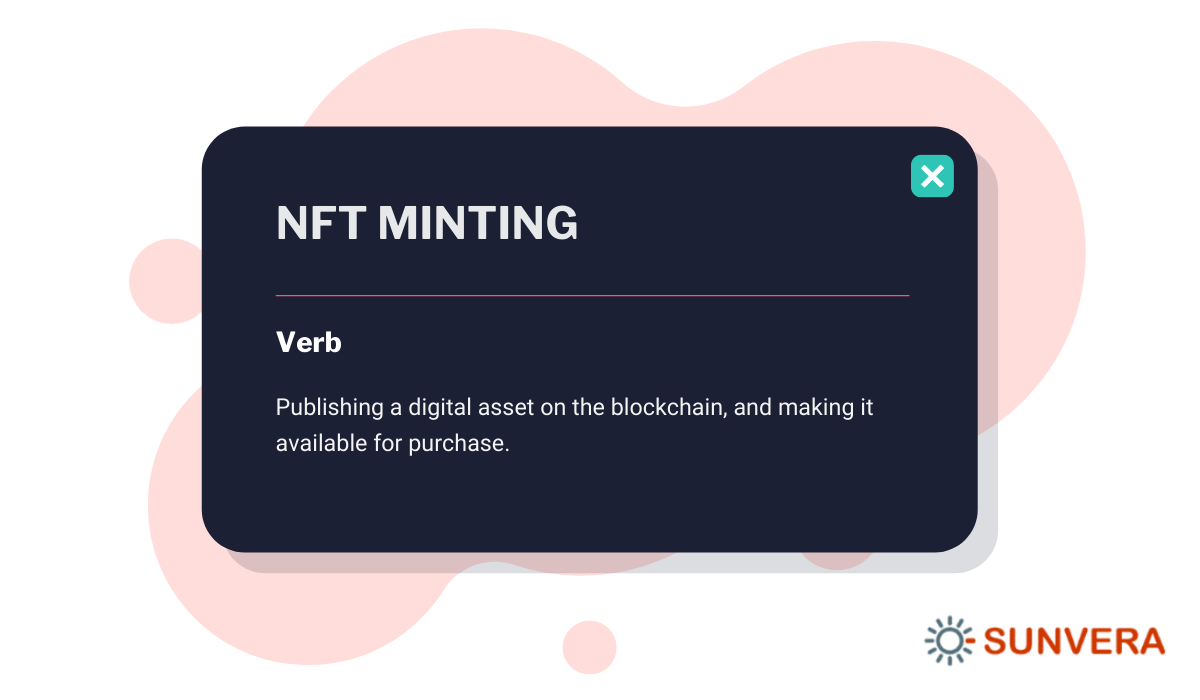
Key Considerations Before Building an NFT Minting Platform
In order to build an NFT minting platform, there are several points to note about minting NFTs, to give you an idea on what features your platform should include for users.
- Minting an NFT is easier than most people think. After setting up their crypto wallet, all they need to do is upload the digital asset file, create the terms and conditions for the smart contract, and finish it off with a selling price. NFT minting platform creators must keep these three steps in mind in order to create the platform.
- You must know the different blockchains that support NFT tokens. Some of the top platforms include Ethereum, Flow, Solana, and Binance. Ethereum is the most widely used platform for NFT developers.
- Consider the advantages and the need for NFT minting platforms. No one can deny that NFTs are a huge trend right now, and the various advantages such as decentralization and increased profits for artists and the like indicate that these tokens will stay for quite some time, if not forever. If this is not enough, many crypto enthusiasts are finding NFT minting platforms to be an attractive option due to benefits such as trading globally, the ability to mint unlimited NFTs, and market visibility.
- Decide what features will be included in your NFT minting platform. When putting together your plan for the platform, you should have a clear plan on what your homepage design will look like, how you will allow users to connect their crypto wallet to your platform, how you can simplify the minting process for users by having an easy-to-work-with interface etc. One of the biggest considerations is if you want your platform to be solely an NFT minting platform, or if you want a combination of both a minting platform and a marketplace. If you choose the latter, you need to make searching for NFTs as simple as possible with the right filters and a ‘sort by’ option.
Checklist to Create an NFT Minting Platform: What You Will Need
In order to develop a good minting platform for NFTs, you or your team should possess the following minimum tech stack.
Blockchain Experience
Since the NFT minting platform will be built on Blockchain, you must have experience working with the top Blockchain platforms like the ones mentioned previously. Ethereum is known as the easiest platform to work with, but you can go for any platform which you or your team might work well with.
Front-End and Backend Frameworks
React.js is typically used as the front-end developer for NFT and blockchain-related projects. Developing the backend will require some expertise in Node.js as well as Express.js.
Smart Contract Development Standards
In order to build smart contracts, you must know the typical standards that are used. The ERC-721 and ERC-1155 standards are used not only for smart contract development, but also represent token standards on Ethereum for safe transfers.
Storage Platforms
You will also want to store NFTs offline with the help of storage platforms. The main NFT storage protocol is IPFS, or The InterPlanetary File System. This peer-to-peer network allows you to store your media files away from the blockchain for offline access. It also secures NFTs in the sense that it prevents others from replicating the same digital asset because of its content identifier feature, which can only be assigned to one unique content piece at once. Pinata is another well-known platform for NFT data storage.
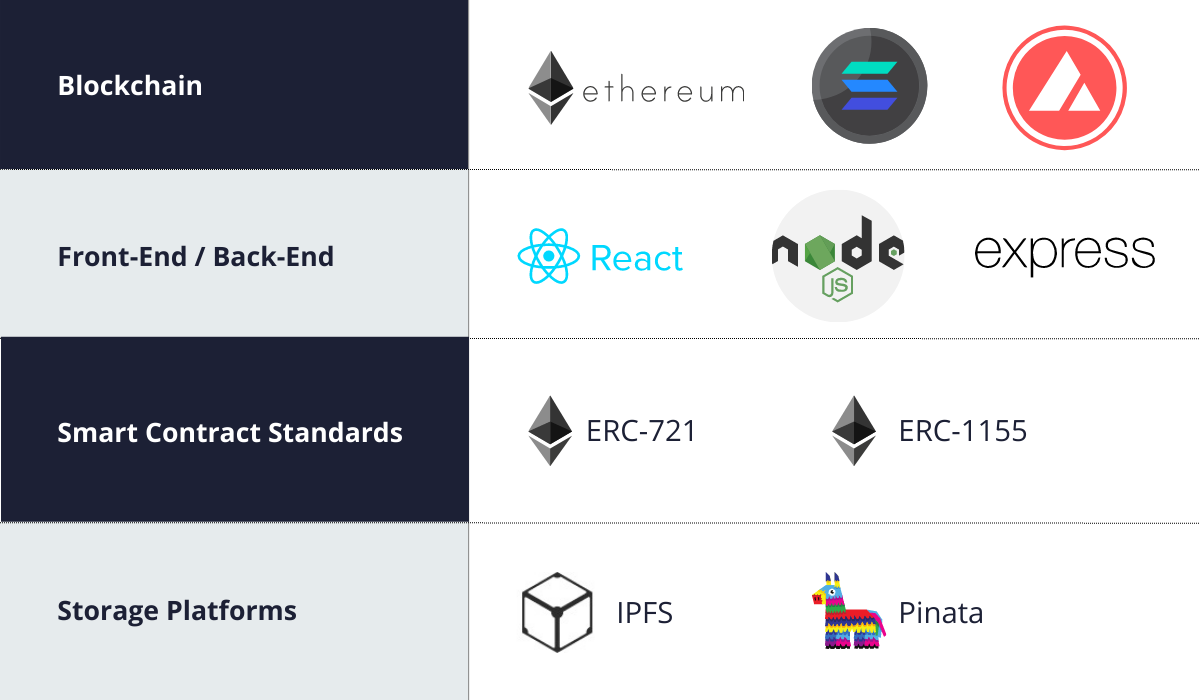
Steps to Create an NFT Minting Platform
The first thing you’ll need is a good blockchain platform to build your minting on. There are many different options available, but we recommend using Matic (a level 2 blockchain) or Ethereum. Both offer a range of features and functionality that is perfect for this purpose.
The steps to create the platform are:
- Setup Javascript development environment with Nodejs – use either Expressjs or Reactjs.
- Setup IPFS nodes and connect to the network (alternatively use Piñata)
- Deploy an NFT contract
- Program Tatum.io API to perform ground-level operations
- Publish the platform and mint NFTs!
Step One: Setting up Your Development Environment
To create an NFT minting platform, you will need to set up a development environment. This can be done using Nodejs and Expressjs or Reactjs. Once you have set up your development environment, you will need to install the Tatum.io API.
In order to install the Tatum.io API, you need to go to their website and click on ‘Get API key’ on that specific product page. Tatum also has the option for Javascript with Tatum JS, but if you are looking for other options, you can check this out.
Step Two: Setting Up IPFS Nodes and Connecting to the Network
If you choose to use IPFS nodes, you will need to connect them to the network and set up permissions.
Alternatively, you can use Piñata to manage your NFTs. On their website, Pinata states that they are the only solution that allows users to hide their files from the public IPFS network. The process of making these files private is referred to as ‘submarining’. With Pinata, you can have access control with custom permissions, and have the ability to make the files public whenever you want.
Step Three: Deploying an NFT Contract
To mint NFTs, you will need to deploy an NFT contract. There are several open-source contracts available that can be quickly customized and deployed. You will also need to have some technical competence, especially if you’re working with a contract that has already been written by someone else. In order to deploy a contract, you need to write the deploy script. This involves creating a file called “deploy.js”. You can read up on this more here.
Step Four: Programming the Tatum.io API
Once you have deployed your NFT contract, you will need to write code to use Tatum.io API to perform ground-level operations. This will include such tasks as creating new NFTs, retrieving information about existing tokens, and issuing transfers.
Step Five: Publishing Your Platform and Minting NFTs!
Once you have completed all of the steps listed above, it’s time to publish your platform and start minting NFTs!
Current Trends in NFT Minting
When it comes to NFT minting, there are numerous trends going around, some that will only become more mainstream, and others that could easily be termed ‘fads’. You decide which trends you would put into which category.
NFT Art
If there is one industry that really knows how to make good use of NFTs, that is the digital art industry. Artists are quickly hopping on the NFT trend as a second attempt to make generous profits off of their art and get credit for their own work. There are artists making thousands of dollars for their digital assets!
Gaming with NFTs
We briefly discussed previously that NFTs are being applied to the gaming world, with the ‘play-to-earn’ model and more. There are a number of gaming companies that are moving towards a tokenization model, which would involve players spending money to unlock in-game features. What’s even more cool is that people are buying ‘virtual real-estate’ in some games with NFTs! This brings us to our next point…
NFT Real-Estate Transactions
Yes, you can now buy property with NFTs in some games. The game ‘Decentraland’ is one such example where people are buying land and building on it. These virtual worlds are only going to become more popular as time goes on and technology improves.
Web 3.0 Identities
Since Web 3.0 will already be decentralized, it’s safe to say that NFTs can easily take over in this field. One way that NFTs can serve a powerful role in Web 3.0 is to help create digital identities. This is to ensure that each person will have their own unique identity, and that nobody will be able to have the exact same identity.
Independent Musicians
You remember when we discussed how artists lose potential profits by working with art galleries and other middlemen? The same goes for the music industries. Music artists go through more pressures because many record label companies and music streaming platforms snatch away the artists’ creative freedom. Having to commit to these companies is a major pain for singers and bands, and so they are turning to NFTs. Music artists are selling their discographies as NFTs and releasing their content on decentralized music platforms. The TV industry is also quickly hopping on the same trend.
Wearing NFTs
Luxury fashion brands such as Gucci and Hermes are utilizing NFTs to provide their audiences with exclusive and immersive content. These high-end fashion brands have started to release digital art and experiences that can only be accessed if you wear their clothes. For example, you might need to own a pair of Hermes shoes in order to see an animated short film or experience an art installation. This is a great way for these companies to increase customer loyalty and engagement.
Monetizing Social Media
There are talks of making profile pictures an NFT. Also did you know that there are tweets being sold as NFTs for millions of dollars? It might sound ridiculous, but it’s happening. As we move towards a more digital world, it was only a matter of time before social media would be tokenized. We are already seeing platforms like Reddit and Twitter experimenting with NFTs, and it won’t be long until this becomes the norm.
Where NFTs Are Headed
The future of NFTs is looking very bright, and we can expect to see many more innovative applications and use cases in the years to come. Here are just a few examples of where NFTs might be headed:
Growth of NFT Marketplaces
Right now, OpenSea is the largest NFT marketplace. It sells anything from art pieces to other rare collectibles. There are many other marketplaces following it’s lead, such as Binance and Mintable, and the good thing about these platforms is that they remove the need to be able to code. This makes minting NFTs as simple as possible for everyone. With the growth of NFTs, these marketplaces and minting platforms are expected to grow as well.
Representation of Physical Goods
NFTs have largely been known to represent digital assets only. However, they are being brought to the physical world as well. People are able to claim ownership of a tangible item with an NFT token. For example, if someone wants a rare hoodie of a certain fandom, they can trade the NFT token to receive the hoodie in exchange. Upon the exchange however, the NFT token must be destroyed to prevent replication.
NFTs becoming more ‘social’
If you interact too much on social sites like Instagram, you will often see a message that goes along the lines of ‘we restrict certain activities to protect our community’. Many users have reported that they have received this message even though they have owned their Instagram account for over five years and just enjoy interacting with the app regularly. On the other hand, there are decentralized social media apps emerging which pay users and content creators for the same level of interaction. Now tell us, which one would be more preferable?
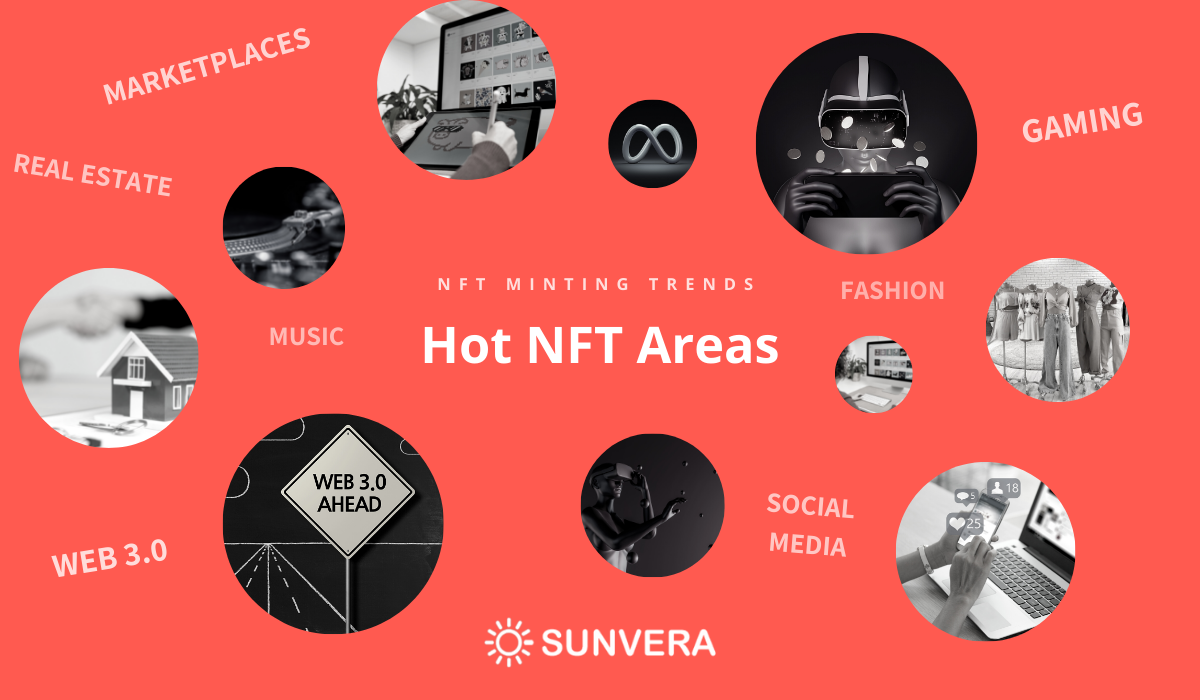
Why You Should Invest in NFT Minting
If you clicked on this article, you must have had a desire to build the next major NFT minting platform, judging by the current demand for it. There are many reasons why you should invest in an NFT minting platform.
For one, there is immense potential to make huge profits off of NFT minting platforms. We are already seeing this with top NFT projects selling for millions of dollars. You can take a look at these millennials making large profits selling NFTs.
In the next five years, the world is expected to shift more towards immersive experiences with the emergence of artificial intelligence, virtual reality, and augmented reality. Throw cryptocurrency and NFTs into the picture and we have a more immersive world. People will start spending more and more time in these digital realms, that the growth of NFTs will be (and already are) inevitable.
We are only seeing the beginning of what is possible with NFTs, and we can expect to see even more amazing things in the future.
Sunvera Software develops next-level software applications from start-to-finish. We are a premier software and mobile app development agency specializing in healthcare mobile app development, custom mobile app development, telehealth software, sales dashboards, custom mobile app development services, retail software development, supply-chain software, ecommerce, Shopify, web design, iBeacon apps, security solutions and unified access software.
We are proud partners with Amazon AWS, Microsoft Azure and Google Cloud.
Schedule a free 30-minute call with us to discuss your business, or you can give us a call at (949) 284-6300.

